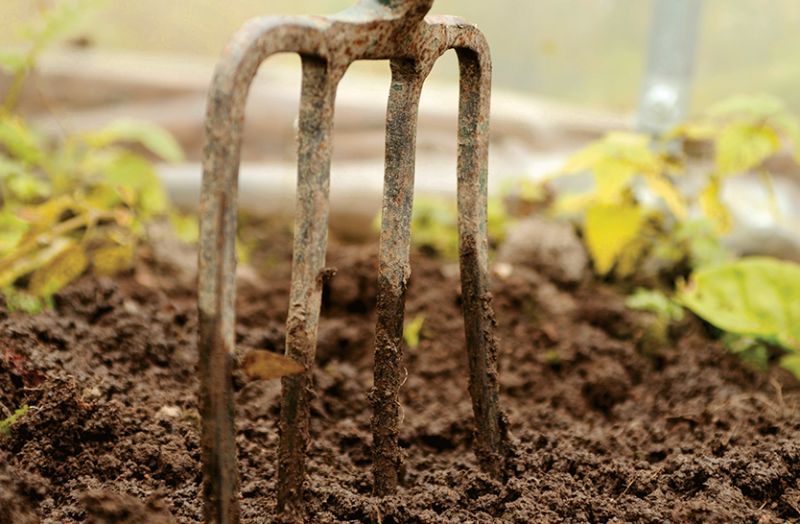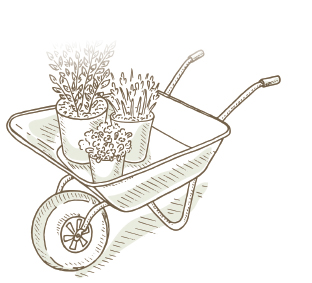Stone by Stone
 It’s digging time. The spring has been cold and wet, the soil is heavy and sodden. Still, it has to be turned. It’s slow work and just one narrow row of pushing and lifting the garden fork, dropping and loosening the hard lumps with strategic whacks, has me puffing and sweating.
It’s digging time. The spring has been cold and wet, the soil is heavy and sodden. Still, it has to be turned. It’s slow work and just one narrow row of pushing and lifting the garden fork, dropping and loosening the hard lumps with strategic whacks, has me puffing and sweating.
“Only one small row and I’m in this state?” I ask myself. “How will I ever get this whole garden dug?”
I know the answer. One forkful at a time.
If I were to use a mechanized tiller it would be faster and easier, and well-meaning friends often offer this advice every year. However, I’ve noticed that turning the soil forkful by forkful gives dirt that is laced with earthworms, while soil worked with a tiller doesn’t seem so packed with these amazing wiggly garden helpers. I changed from using a shovel to a fork, because it is kinder to the worm population.
Somehow, every year, the soil is turned and then planted. At the moment it feels like a daunting and formidable task, but if I look just at the area in front of me it feels doable. If I look at the whole garden and what is yet left to accomplish, it feels impossible. Carl Jung commented, “Nothing is more important than this day.” To condense that idea further becomes, “Nothing is more important than this moment.” In this moment, I can dig another forkful of soil from what lies at my feet.
Looking at what needs doing in the whole garden, instead of what I am immediately working with, diffuses my focus. Of course I can keep the whole garden in mind, lift my head and look around, appreciate the blooms of daffodil at the end of the bed, the fluttering of warblers in the cherry tree, the delicate breeze scented with new grass and the whole context in which this gardening is done at all. But I also need to hold the importance of the task right before me.
In early university days my diligence to study was not strong. I procrastinated and found myself overwhelmed with deadlines that felt insurmountable. My thinking often went something like: “Well, I’m so behind already that even if I apply myself to this assignment, it’s hardly anything compared to how much still won’t be done. So I might as well say yes to the invitation to go out with friends.” The fallacy of that approach is embarrassingly obvious now and viewed from my current perspective it’s easy to see how I sabotaged getting my assignments completed.
This unhelpful approach began to shift as I observed the effects of procrastination and preferred approaching tasks without panic. In the process of turning over thoughts along with turning over dirt, I’ve become aware of the impact of doing things a bit at a time, and how much is accomplished this way. This wisdom, lost to me in earlier years, is found in long ago tales like ‘The Tortoise and the Hare’ from Aesop’s Fables, which reveals the potential of a slow and steady effort.
In Franco Zeferelli’s enchanting film about Saint Francis of Assisi, Brother Sun, Sister Moon, the legendary Donovan put this theme to music, describing how the small team of early devotees rebuilt an abandoned church:
Day by day, stone by stone, build your secret slowly.
Day by day, you’ll grow too, you’ll know heaven’s glory.
There must have been a receptivity to this idea, a weariness of putting things off and facing the intensity of too many papers, exams and projects, because the song had an impact and became a favorite with me. Even today, turning over forks of dirt, it comes to mind and I find myself singing it, an encouragement to keep on with the small tasks of the moment.
My friend Ben undertook a large project of making a drum, right from the basics of cleaning and tanning a hide, cutting and planning the cedar for the frame, sanding and gluing. This work takes up a lot of space and Ben has a modest, simple workspace, but week-by-week, he gets a piece of the job done.

“I’m not a person who does things in the big outburst of energy,” he explained. “I go at it steadily. But I persevere.”
His statement evokes the story of Scott Nearing, co-author of Living the Good Life. It is told that he dug a large pond on his land by digging two buckets of earth a day. It took a long time, but like Ben, he persevered and eventually had a large pond.
The more I mull over this approach, turning over another row of dirt in the process, the more examples arise of its efficacy. Regularity in practice or a project of any kind reveals a deep wisdom, the way this overturned and rich dirt reveals a wealth of helpful worms. I hear the words of my teacher, and recall the words of many guides:
Be regular, meditate daily, even if it’s just for a short time.
It bears much more fruit than long periods now and then.
I don’t want you to think that my early adult tendencies are entirely transformed. They turn up in many places, although it is in the garden that clear success is evident. While writing, I have yet to master the ‘short bits at a time’ skill. On larger writing projects I look for large blocks of time, but the nature of my life is that large blocks of time are difficult to create. I’m beginning to question whether it is my concept about needing these large blocks of time that will have to be revised. I’m learning to write when smaller bits are available. It keeps the story going, keeps the ideas burbling up, and keeps my receptivity alive, active and perceptive.
What am I choosing to express in my life?
What qualities do I want to strengthen?
What values do I choose to live by?
How can I manifest these?
Then, the things that get in the way of these
choices can be faced, transformed, and left behind.
In the same way, whatever I practice regularly and repeatedly opens the gates for where my attention goes. The wisdom of my teacher’s words expands. There’s much more potential in this regular approach, bit by bit, than just completing a task. It might mean overturning a whole way of being.
Every year the dirt is turned, the harvest comes in, shaped by temperature, rain, wind and cultivated attention. And what, I wonder, leaning in to lift another forkful of dirt, is my inner harvest of applying this wisdom?
Syndicated from Heartfulness Magazine. Find them at Heartfulness.org or on Facebook. Author Alanda Greene lives in the Purcell Mountains of British Columbia, Canada. Having a deep connection with nature, she and her husband built their house of stone and timber and a terraced garden, and integrated their life into this rural community. Alanda’s primary focus is the conscious integration of spirit with all aspects of life.


On Dec 2, 2017 Patrick Watters wrote:
Ah yes, this is life at "Godspeed" (3mph), the pace of being known and knowing, where slow is fast, small is big. www.livegodspeed.org
Where working with our hands and hand tools is good for us physically and spiritually.
};-) ❤️ anonemoose monk
1 reply: Transcending | Post Your Reply